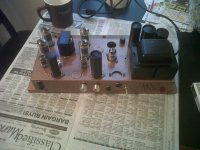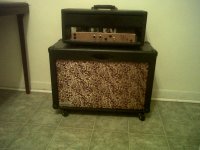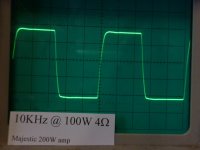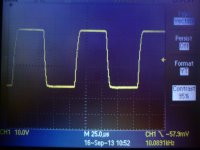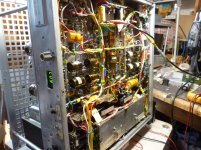Schematic needed for a Conn UA 6026 organ chassis - do not have any other information on this unit, but I just could not pass it up - it has tube positions for 4/7027A, 2/7868, 2/7199, and 2/12AX7 - just the 7199 & 12AX7 are missing. Everything else appears (cosmetically) good.
I did not get a chance to look under the hood, but I think it has potential as an audio amp or guitar amp. Does anyone have any information on converting an organ amplifier to audio or guitar use?
Thanks for any help.
nuvo😀
I did not get a chance to look under the hood, but I think it has potential as an audio amp or guitar amp. Does anyone have any information on converting an organ amplifier to audio or guitar use?
Thanks for any help.
nuvo😀
I'm working (having a pro do it) on a conversion of a 6026 Conn right now. The amp is a stereo 20/20w rms. a mono preamp will be directed to one side. the 3-way standby will be A+B - Standby - A. Amp B will default from the Pre unless a second pre is pluged in. Each amp will have its own output. More info as project progresses.
I have one of these too and am looking for a schematic. I am hoping to use this as a stereo amp with subwoofer on the third channel. This will make a nice Hi-Fi amp. Very quality build with nice iron on it.
I doubt the unit is so complex you can't reverse engineer it. I have traced many a schematic diagram; it just takes patience. On top of that, you probably can draw most of it without looking anyway. Four 6L6s either push pull parallel or push pull two channels (probably the latter). Solid state rectifier. The only hard part would be the bias circuit and the tone controls, if any.
Conn Organ 6026 to Guitar amp. Done
Well, the conversion of the Conn 6026 Organ amp to Guitar amp is complete. I like it alot!! If anyone has a 6026 they want to sell let me know. I would love to have a second as a backup amp. here are a couple pics.
Well, the conversion of the Conn 6026 Organ amp to Guitar amp is complete. I like it alot!! If anyone has a 6026 they want to sell let me know. I would love to have a second as a backup amp. here are a couple pics.
Attachments
I've got an old Baldwin amp that I believe used to be a 100 watt mono amp from some recent research I did on the web. It was converted over to stereo operation a few years ago and I finally got it back up and running a month or so ago. It's now rated around 23 watts per channel and sounds great! And just like the Conn amps, the Baldwin has some massive quality iron.
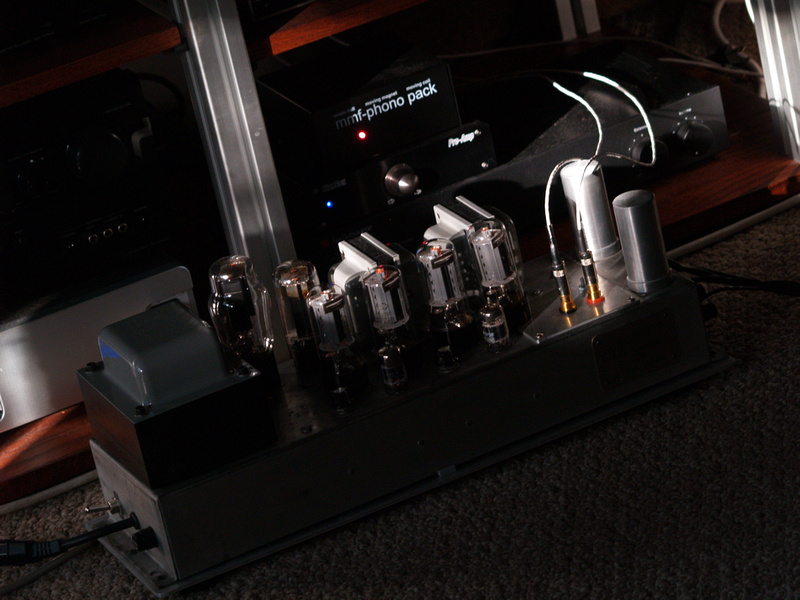

I've got a Conn 6050 amplifier (tubes/valves included) that I'm attempting to get to work as a guitar amp head. It is missing all external connectors (Power 1 & 2, Internal & External Speaker, and Expression Control). I need a source for a schematic for this amp + all external wiring so I can get this working. Any ideas where I could find such a beast?
Conn 6026 w/ cathode follower preamp
I have a schematic for the Conn 6026 Chassis (modified) email me for a copy an notes. me@markeckard.com
I have a schematic for the Conn 6026 Chassis (modified) email me for a copy an notes. me@markeckard.com
Anyone with a schematic for the Conn 7868? I have one to go with the mods for a stereo amp.
THX in advance.
THX in advance.
Schematics For Conn Organ
I have a Schematic for a Conn 541 Organ that has a tube layout like this the chassis number is not something I know right now as my organs are stacked like cordwood(maybe 59092-7 on schem). I got the original repair manual from a source that sells the whole manual. They are organ enthusiasts so it is not a good idea to pose the proposition we are discussing.
The schematic is a 3 part fold out with parts on other pages. In a nutshell, mine uses the poweramp section to power up the amp as well as the offboard tubes that are 12au7's used as keyers(so #24 tubes using both halves one key each). There is also an output for the Leslie. The amp uses an OA3 tube for voltage regulation. By the way the Organ is 1963 with Cleveland 12" Alnico speakers.
The Two problems with the conversion I have found so far is that the amp is basically a 2 channel amp with one channel called Flute and one channel called String. The difference in the amp is non-existant. The amp is just a Stereo Amp. The second problem is the preamp for the String and Flute channels are off board in the top of the organ and it is Solid State? 1963??Solid State preamp's were cutting edge and expensive. There are transistors and the both channels are colored with different tone parts (caps etc..) to make the flute(hollow bass) and the string(high treble). Oddly there is also a tube in the preamp but it is a tremelo circuit. So in a nutshell we have a Power stereo amp needing a preamp and tone section. It would be easier to convert this to Audiophile Stereo use.... However the Power Transformer is built large to power up all the key tubes and the other tubes, so it can easily handle a couple preamp tubes.
I have a Schematic for a Conn 541 Organ that has a tube layout like this the chassis number is not something I know right now as my organs are stacked like cordwood(maybe 59092-7 on schem). I got the original repair manual from a source that sells the whole manual. They are organ enthusiasts so it is not a good idea to pose the proposition we are discussing.
The schematic is a 3 part fold out with parts on other pages. In a nutshell, mine uses the poweramp section to power up the amp as well as the offboard tubes that are 12au7's used as keyers(so #24 tubes using both halves one key each). There is also an output for the Leslie. The amp uses an OA3 tube for voltage regulation. By the way the Organ is 1963 with Cleveland 12" Alnico speakers.
The Two problems with the conversion I have found so far is that the amp is basically a 2 channel amp with one channel called Flute and one channel called String. The difference in the amp is non-existant. The amp is just a Stereo Amp. The second problem is the preamp for the String and Flute channels are off board in the top of the organ and it is Solid State? 1963??Solid State preamp's were cutting edge and expensive. There are transistors and the both channels are colored with different tone parts (caps etc..) to make the flute(hollow bass) and the string(high treble). Oddly there is also a tube in the preamp but it is a tremelo circuit. So in a nutshell we have a Power stereo amp needing a preamp and tone section. It would be easier to convert this to Audiophile Stereo use.... However the Power Transformer is built large to power up all the key tubes and the other tubes, so it can easily handle a couple preamp tubes.
Last edited by a moderator:
The original schematc is similar to a Dynaco 70, or mark III for the 7027 channels,I could not find the schematic anywhere,I converted mine to the Mullard 5-20 schematic,with the proper feedback corrections, It sounds great,and seems fairly flat frequency wise.
Conn organ amp Mullad 5-20 conversion schematic
Here is the schematic I used
Here is the schematic I used
An externally hosted image should be here but it was not working when we last tested it.
Last edited:
10Khz square wave output Conn amp
An externally hosted image should be here but it was not working when we last tested it.
An externally hosted image should be here but it was not working when we last tested it.
That 10Khz waveform taken; what was the output level ?
richy
... I would have expected that more like at 10-15W; and you are content with the sound ?
John Moyles article that appeared in my late youth was a revelation, and I consider it the most informative hands on. http://www.tubebooks.org/file_downloads/moyle_amp.pdf
richy
John Moyles article that appeared in my late youth was a revelation, and I consider it the most informative hands on. http://www.tubebooks.org/file_downloads/moyle_amp.pdf
richy
Hi Richy,
1 watt was the test signal, it'll put out an easy 25 watts before clipping starts,it has 20 db of feedback and sounds great to my ears. it is pretty flat from 20-40khz I don't have a way to get accurate numbers at the moment.just from looking at the scope.
Nice article, I just skimmed it,I'll have to read it more thoroghly
Scott
1 watt was the test signal, it'll put out an easy 25 watts before clipping starts,it has 20 db of feedback and sounds great to my ears. it is pretty flat from 20-40khz I don't have a way to get accurate numbers at the moment.just from looking at the scope.
Nice article, I just skimmed it,I'll have to read it more thoroghly
Scott
Last edited:
Becareful with a power 10KHz squarewave test into a dummy...this is the nastiest test for any amp and it will test any snubber in the output stage and tube screen(s) resistors, and also any softy cathode resistor.
In general, I do the test at 1/2 total output power as in practice this amount of power is never reached in audio, but illustrates high end stability.
Watch out for scope probe earths too, an earth loop chassis earth via other earthed equipment via mains will make it look weird...when moving leads around.
Two waveform photo's of as seen from two different screens, the advantage of the Hameg analogue over the lumpy digital Tekt. The amp is a 200+200W (8xKT90) Williamson...so much for those who question the stability aspect.
Each channel of this amp is capable of a 200W 10Khz sine but I don't force it, certainly not with a power squarewave. resp -3dB at ~60Khz. The size of the o/p transformer (lower left) capable to 15Hz at 200W, and HF testing with the high interwinding capacitance will stress the whole output stage.
Moyle's article rubs salt into the wound of rising engineers...grappling with stability and non optimal waveforms. I tend to look at this from a mathematical aspect, akin phase lock loop designs but tube amps are notorious for having issues their own ways.
If one can crack them, then it's the ultimate nirvana in p-p design. Take care.
richy
In general, I do the test at 1/2 total output power as in practice this amount of power is never reached in audio, but illustrates high end stability.
Watch out for scope probe earths too, an earth loop chassis earth via other earthed equipment via mains will make it look weird...when moving leads around.
Two waveform photo's of as seen from two different screens, the advantage of the Hameg analogue over the lumpy digital Tekt. The amp is a 200+200W (8xKT90) Williamson...so much for those who question the stability aspect.
Each channel of this amp is capable of a 200W 10Khz sine but I don't force it, certainly not with a power squarewave. resp -3dB at ~60Khz. The size of the o/p transformer (lower left) capable to 15Hz at 200W, and HF testing with the high interwinding capacitance will stress the whole output stage.
Moyle's article rubs salt into the wound of rising engineers...grappling with stability and non optimal waveforms. I tend to look at this from a mathematical aspect, akin phase lock loop designs but tube amps are notorious for having issues their own ways.
If one can crack them, then it's the ultimate nirvana in p-p design. Take care.
richy
Attachments
Last edited:
- Home
- Live Sound
- Instruments and Amps
- Conn organ conversion to amp
